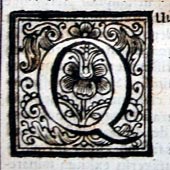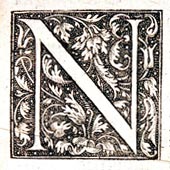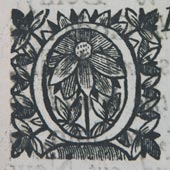Cabinet 05: Floriated Initials
Floral motifs have been a consistent feature of decorated initials, from traditional manuscript initials to modern press interpretations. Representations of flowers can be both stylised and realistic, and are incorporated into various styles of initials including "passe-partout" and ornamental letters. On display are three examples of printed floriated initials from the 1600's and 1700's.

The decorative swirls and shape of the flower head incorporated into the Q initial in Reformatio legume are somewhat reminiscent of a paisley pattern. In England during the 1700's, paisley was a popular motif for women's shawls (Reilly). However, as this English book was printed in 1640, it seems unlikely that the similarity is deliberate. The dark border and shadowing on the Q accentuates the decorative detail of this initial.
Church of England, Reformatio legum ecclesiasticarum, ex authoritate primum regis Henrici 8 inchoata: deinde per regem Edovardum 6. provecta, adauctaque in hunc modum, atq; nunc ad pleniorem ipsarum reformationem in lucem edita. Londini, Typis T. H[arper]. & R. H[odgkinson]. Impensis Danielis Frere, 1640. Shoults, Eb 1640 C

There is an apparent match between an initial Q on page 4 of Isaaci Casauboni, (designed in the same style as this N) and a Q exemplar specimen found in Carol Belanger Grafton’s Historic Alphabets and Initials: Woodcut and Ornamental (p.103). Based on this observation, this N could be tentatively identified as being possibly part of a sixteenth century decorative alphabet printed in Lyons by Jean de Tournes. An influential French printer, Jean de Tournes was a leader in experimental typography of the 16th century. He produced high quality printed works and was appointed Royal Printer at Lyons in 1559, an honour which was later also bestowed on his son. Jean de Tournes died of the plague in 1564.
Isaac Casaubon, Isaaci Casauboni de rebus sacris & ecclesiasticis, exercitationes XVI : ad Cardinalis Baronii prolegomena in annales et primam eorum partem, de D.N. Iesu Christi nativitate, vita, passione, assumptione : cum prolegomenis auctoris, in quibus de Baronianis Annalibus candide disputatur.Genevae : Sumptibus Ioannis Antonii & Samuelis De Tournes,1663. Shoults Swb 1663 C

Like the Q in Reformatio legume, the body of the initial O in The history of the Royal-Society partially frames the flower head. The style of leaf, lack of a border, design of the mound on which the O sits and its overall composition suggests that this initial is perhaps part of, or is inspired by, or based on, 17th century Dutch initials as illustrated on plate 72 of Nesbitt’s Decorative Alphabets.

